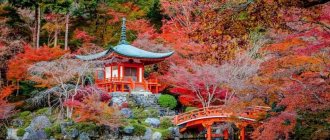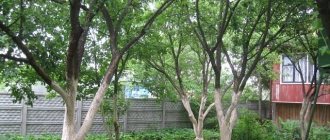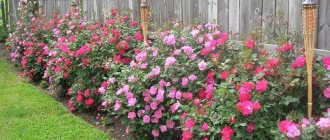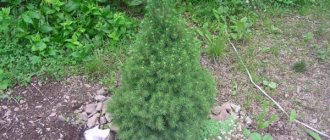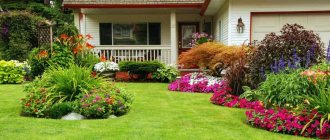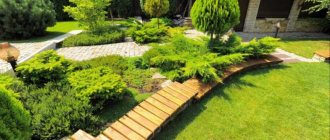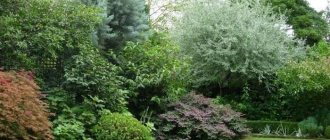Common features
The appearance of a traditional English-style garden continues to be an example of landscape art for many. The described direction was formed to create an alternative to the regular French park. At the end of the eighteenth century, many were already tired of the geometrically correct layout, which had pronounced symmetry with straight alleys, parterres and ponds. It was impossible to be too distracted from the theme of classicism at that time; his ideal paintings were in fashion. But society was tired of the effect of man’s absolute control over nature, so the idea of creating a park appeared, which outwardly looked like a man-made natural extension of the surrounding landscape.
The beauty of nature within the framework of man-made processing Source standard.co.uk
The creators of such creations sought a balance between interference with natural nature and its unbridled temperament. Therefore, the new trend was based on the principle of the element of unpredictability. Walking through such a park, a person did not know what awaited him around the bend of the alley. To realize such aspirations, a variety of picturesque elements were used (small bridges, pavilions, fountains, flowerpots, pyramids, decorative structures stylized as ruins).
Gardens in the style described have an amazing sense of proportion; they look noble and picturesque. Their aesthetics are highly functional. The principles of its construction are considered unshakable. They can be used by anyone who dreams of creating a small green corner in the style of old England in their dacha. To do this, you must adhere to the following rules.
Lush noble beauty Source pinterest.com
Basic structure
An English garden in landscape design is an object with a clearly planned structure. Its basis is walking areas, the routes of which allow you to observe the change of decorative objects. Their selection is strictly limited. The generally accepted ones are:
- large green lawn ;
- front garden;
- open light gazebo in the form of a pavilion;
- a garden created from fruit or ornamental trees;
- picturesque pond .
All these zones are separated from each other by walls made of stone, reminiscent of ancient ruins, or by impeccably trimmed green fences. When placing the listed objects, it is necessary to adhere to strictly defined boundaries.
Stone walls in a classic garden Source yandex.ru
The space between the decorative inserts is united by routes intended for walking. They are formed using paved paths or soft paths sprinkled with gravel. Along them you can plant flower beds and make ridges. You can complicate the task and place them inside green boxwood labyrinths. The business card of landscape design in the style of an English park is one-sided or two-sided mixborders.
Multi-colored flower beds
The main composition of any garden is a bright flower garden of perennials. Choose different plants to create a whimsical combination of many shades and shapes. Combine spring, summer and autumn flowers. The most preferable for the middle zone are begonias, delphiniums, dahlias, carnations, lilies, hydrangeas, petunias, daisies, cornflowers, peonies and other plants.
Style elements
Despite the fact that the natural beauty of nature is at the forefront, the garden described can only be called as close to natural forms as possible only conditionally. In its implementation one can always feel the experienced hand of a gardener with a capital G. Therefore, the overall picture includes trimmed fences and well-mowed lawns. Free landscape plantings fill the empty areas that remain after identifying the main accents (promenade alleys, architectural elements, green labyrinths).
Romantic corner in the garden Source roomester.ru
The garden in England imitates not pristine nature, but a pastoral picture in which a fairy-tale atmosphere dominates. Branched thickets and overgrown bushes are not for the object being described. There is only room for perfectly trimmed corners. All accents used should emphasize aristocratic luxury and resemble the appearance of a colorful postcard prepared for an art exhibition.
Classics within classics – that’s what landscape design is in English. If shrubs are needed, then boxwoods should act as them. If you need to plant trees, it is better to use maples, catalpas or wild apple trees. Their favorite partners are catnip, heuchera and delphinium. The lower tier is most often decorated with lavender and veronica. Bulb plants (tulips, muscari and daffodils) look good in such splendor. For several centuries in a row, this combination has not gone out of fashion. All together, they don't look boring.
The principle of multi-tiered design Source pinterest.es
Each designated plant has its own distinct personality. If you can choose them taking into account shapes, sizes and colors, you will be able to accurately recreate the style of an English aristocrat.
Greens in a plane
The color of lush greenery always dominates the gardens of England. You can’t do without a lush lawn. It unifies the overall composition, serves as its main background, fills the resulting bald spots and balances the flower beds. Without the use of such a technique, it is impossible to achieve natural harmony and create the splendor of charm.
Emerald-colored base for framing perennials Source pinterest.com
See also: Catalog of companies that specialize in landscape design of sites.
If you want to organize something similar on your personal plot, you need to make strict lawns, create a border of greenery around ponds, connect or ridges and create walking routes. The lawn should become a backdrop for admiring everything that is in landscape gardening.
A scientific approach to plant selection
Despite the fact that the English style in landscape design implies the creation of zones of equal importance, the basis for the success of the general idea is that the choice of plants should be carried out on a strictly individual basis. The owner is obliged to know everything about each of them: the nuances of planting, care, reproduction.
There is no way to save time in this matter. Therefore, it is advisable to start a separate journal and compile catalogs in it, describe the stages of work for each specific species, build schedules for watering and fertilizing, tillage, weeding and resettlement. The garden will have to dedicate itself to itself and constantly look after it, like a small child. It is important to do this thoroughly, using a scientific approach, constantly studying the experiences of other gardeners and communicating with them on forums. This approach will make it easy to adjust existing ensembles.
A well laid out flowering garden Source pinterest.com
Color balance
Harmony in color is another basic principle. The ability to achieve it and then maintain the garden in the required form at any time of the year is a task for professionals. There is nothing complicated about this if you know how to build a color scheme. Here you need to act like a skilled artist: take a basic foundation and, starting from it, skillfully use different shades.
The described garden does not have faded colors, contrasts or boring undertones. Aristocratic landscapes are those in which a calm green palette dominates; every colorful and rich element has its own counterbalance, and every light color is adjacent to a dark, rich, deep tone. When compiling a range, you need to use a combination of shades that are adjacent to each other. For example, it is good to mix purple with lilac, yellow with orange, blue with cyan.
Unearthly charm
Your garden should become such a “decoration” that it is impossible to pass by indifferently. He invites you to come in, take a walk and linger for a while in his green “embraces.” The cottage garden gives the impression of incredible abundance. The arches and gates are decorated with vines. The gazebos are covered with roses. The flower beds are overflowing with bright flowers and greenery. Delphiniums, hollyhocks, irises, hydrangeas, catnip and carnations are all flowers that can be part of your future garden. In fact, such a garden should reflect your character and personality. And all this must be done in limited space.
Video description
The video shows how the English Garden Museum was created in London, where purely English landscape design is presented:
Water sources
In English parks you can find small springs, small fountains, and well-groomed ponds. All of them have high decorative functions, and they can be used for watering plants.
A pond with a stepped waterfall in a luxurious green frame Source yexplore.travel
Solving such elements requires serious material investments. The size of the reservoirs should be impressive, the banks should be high, and the plants should be planted in large groups.
Careful care
A garden in the spirit of good old England should be surrounded by great love. This style is best suited for those who like to tinker with plants: pruning roses, mowing green lawns. Everything needs careful care, you have to put your soul into everything. Therefore, such a creation will not suit lazy people. Even one neglected bush, a withered bud, a dry shoot will immediately destroy the splendor created by your hands. And there can be no talk of weeds. So careful care is another principle of creating English design.
Decor features
Arches
They will emphasize the smooth rounded lines of the garden, add splendor and become a support for hanging roses and clematis. A whole corridor of several arches, entwined with flowering vines, looks romantic. They are installed closer to the center of the garden, sometimes preceding the entrance to the gazebo. The arch between the hedges is like a door to another “garden room”.
Unusual arches from tree branches
Sculptures
Several sculptural objects in different corners of the site will set the rhythm of the landscape. They are located both in central areas, near benches and gazebos, and in the most unexpected places: under a tree, behind a hedge, inside a grotto, in the thickets of a pond. Antique-style statues and vases, forged or stone birdbaths are a sure way to bring the spirit of antiquity and aristocracy into the garden.
Sculpture surrounded by living borders and flower beds
Pergola
Like an arch, it also serves as a support for flowering vines. But forget about complex large structures with bulky beams. In the English garden, compact wooden pergolas combined with trellises are popular. They are often used instead of arches, preceding the entrance to the main lawn. A good idea is to place them near benches at the back of the garden.
Corridor of pergolas entwined with climbing roses
Generalization on the topic
An English-style garden is an artistic creation. This direction is very popular. But in order for its splendor to please the eye throughout all four seasons, special careful care and a scientific approach to the formation of plant groups are needed. Inside such an object, everything is lined up in the correct geometry, but it is visible only from a great height. Inside, everything is mysterious and laconic. Around every turn there is a new surprise in the form of an antique sculpture near a waterfall or a wicker bench hidden in a well-groomed flower garden. All these objects are connected by paved paths.
Ratings 0
Signs of a cottage garden
The main distinguishing feature of an English cottage garden is ease of design combined with a clear structure . In such gardens, natural plants and colors , and garden paths lead directly to flower-lined lawns . The front part is topped with an arch, and behind it opens an orchard and a “wild” landscape that requires almost no maintenance.
In the cottage garden you can find homemade furniture, small gazebos and sculptures. Although a cottage garden does not require frequent maintenance, it will take a lot of time to create it, planting plants, and making garden decorations and exterior items. You should find a harmonious combination that will allow you to form a single concept that creates homeliness in an open space. To do this, you need to follow some general principles of its formation.
Suitable plants
The English garden is characterized by spreading deciduous and coniferous trees with an elegant crown of different shades. They create a natural landscape with shaded areas. A good option would be: oak, maple, birch, beech, hornbeam, apple, cherry, willow. For contrast and visual interest, add a few short conifers: spruce, pine, larch.
Deciduous trees with abundant foliage
They are not only responsible for the shade in the gazebo, but also help soften the boundaries, disguise the artificial elements of the garden, and emphasize the poetic atmosphere of privacy and romance. Among the climbing plants in English gardens, clematis, wisteria, climbing roses, virgin grapes, ivy, and medicinal jasmine get along well.
Luxurious climbing roses on the pergola
Continuous flowering
Flower beds that are spectacular throughout the season - from the first bulbous ones to shrubs and trees with decorative bark that attract attention in winter - are the result of thoughtful selection and combination of plants.
Flower beds that are spectacular throughout the season are the result of thoughtful selection and combination of plants
Among them you can find both “high society” (roses, delphiniums, lilies, peonies) and “country simpletons” (mallows, night violets, poppies and even “weeds” - tartar, Echinaceae or sterile varieties of goldenrod). All this is mixed into a beautiful explosive mixture, which will have to be constantly looked after. However, beauty requires sacrifice, and dazzling beauty even more so.
"Organized" chaos
The first cottage gardens were really created “in haste”; their owners wanted to develop the occupied plots as quickly as possible. But later, in such careless naturalness and eclecticism, it was possible to see a special attractiveness. This is how the concept of “controlled” chaos arose, which formed the basis for the creation of new gardens.
- English garden rules. Part I. Classical principles Many of the gardens and parks of this country were created several centuries and even a thousand years ago, and are still admired today. Perhaps the first association that comes to mind when talking about England is lawn, garden, landscape.
Recreation areas
Even a small area looks larger if it is divided into several recreation areas. Formal zoning can be created using walkways and patios or gazebos. If you plan your route wisely, you can arrange it so that a walk through your garden resembles an exciting tour. It will have everything: gazebos dressed in vines, flower arrangements, benches hidden in secluded corners, and those surprises that you yourself decide to arrange for your guests.
Don't forget about edible crops
Perhaps the main conflict of the modern gardener is the imbalance between the desire to grow something beautiful and something edible. Flowers, green crops and vegetables need a lot of sun, but in a traditional garden these crops are not usually planted in one place. In an English cottage garden, dill happily coexists with cloves, and chard looks advantageous against the backdrop of daylilies. The ideal option, combining food for the body and soul, is considered to be beans grown under “wigwams” put together from boards, which they can freely entwine.
Concept and principles
In its philosophy and aesthetics, the English garden is closer not to wild nature, but to pastoral painting. The gardener’s task is to recreate a luxurious idyllic landscape worthy of classic paintings or collectible postcards. Despite their apparent simplicity, English parks are thought out to the smallest detail, including combinations of shades and halftones, transitions and contrasts.
Important: the English garden was the backdrop for traditional country estates of the 18th and 19th centuries.
Landscape garden surrounding an ancient estate in England
The atmosphere in them is conducive to long leisurely walks, pleasant conversation, reflection and contemplation of nature. The English garden gives the impression of aristocracy, slightly beyond the bounds, but without losing its nobility and sophistication. Although he loves space, it is quite possible to arrange it on the usual six hundred square meters. It is important to adhere to a number of principles:
- Plant abundance (use many different flowers, herbs, trees),
- Unity with nature (predominance of curved lines and natural outlines, decor and finishing made from natural materials),
- Spaciousness (lawns and lawns occupy about 40% of the area),
- Flow (soft smooth boundaries, one flows into another)
- Contrast (combinations of shades, volumes, textures),
- Antiques (vintage furniture, aged surfaces, antique-style decor).
Important: when decorating a garden, prefer natural materials such as wood, stone, ceramics, glass, etc.
Lawns and lawns are essential elements of an English garden.
Old things
Old things are a symbol of a cottage garden . Nothing conveys the atmosphere of nostalgia for the old days better than rusty garden tools hanging on the wall, clay pots with salt deposits placed on the steps of an old wooden staircase, or wicker wooden baskets with flowers. You can look for similar items at flea markets.
Left: nothing conveys the atmosphere of nostalgia for the old days like old things. Right: paving and coverings should never look like a remake
Container compositions
Annuals and container arrangements are an important seasonal decoration for a cottage garden . There are three advantages to this technique: flowers in pots can be used to landscape any area, plants can be changed according to the season, and the compositions themselves can be changed even daily, choosing new spectacular combinations or creating themed container flower beds (white, blue, shadow).
Left: Container arrangements are an important seasonal decoration for a cottage garden. Right: Flowering vines help blur the line between home and garden
At the same time, any nice containers can and should be used as pots; it is only important to drill drainage holes in them. This could be old kitchen utensils, hanging bird cages, brightly colored tin cans, out-of-print shoes and anything else that your imagination allows. Read about the intricacies of container gardening in the following materials:
- Secrets of container floriculture
- Where and how to set up a container garden
- Calling to the rescue... container
- Children of the sun from southern countries: exotics in containers
- Container gardening: professional advice on choosing plants
- Ideas for container gardens and vegetable gardens in a small area
